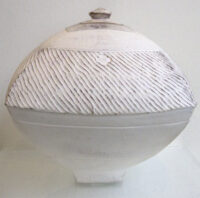Om Steen Kepp
Steen Kepp (1949) er uddannet i Danmark og Frankrig som billedkunstner og grafiker. Han har gennemført studier ved Kunstakademiet i Nice og hos lithografen Pierre Chave i Vence. Hans titler...Læs mere
Viser et enkelt resultat
Viser et enkelt resultat
Mere om Steen Kepp
Steen Kepp (1949) er uddannet i Danmark og Frankrig som billedkunstner og grafiker. Han har gennemført studier ved Kunstakademiet i Nice og hos lithografen Pierre Chave i Vence. Hans titler vidner om en syntese af øst og vest, hvor begge ord associeres til det som udmærker den danske, eller kosmopolitiske keramiker Steen Kepp’s kunstneriske skaben: En meditativ stilhed.Følgende tekst kun tilgængelig på engelsk
The focus of Steen Kepp’s creative quest has now turned towards a more inward-looking contemplative serenity. With the abandonment of the vessel as a recognisable and useful object, the new works seek to embody a search for dignity and silence. His Torii insistently demand respect, even reverence, magically deploying that vocabulary of symbols which we associate with other powerful totems. His Cushions clearly contradict the idea of the container. They are rigid envelopes held in tension by an invisible interior pressure, their iridescent surface inveigling the ambient light into an ambiguous participation in the presence of the object. At no two times of day does it appear the same.
His coffers, similarly decked in this extraordinary coat of saturated copper, are evidently not boxes intended for any conventional kind of storage. Their lids are there as access to a void, access to a quiet carefully-defined volume nestling in the splendour of a jewel-like carapace; – an invitation, if ever there was one, to meditation on the intrinsic complementarity of emtiness at the heart of ritual splendour.
As in Steen’s earlier work when he adopted body and soul an excessively demanding Japanese technique, to then trace a lone and exemplary path across the European ceramic landscape, his new peaces set him apart once again as an artist who employs radical formal and technical innovations in a search for an intelligent synthesis of Japanese Oriental spirituality and the European cultural heritage.
Nigel Atkins

